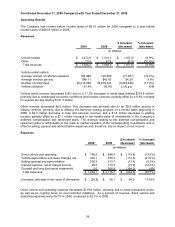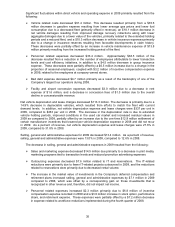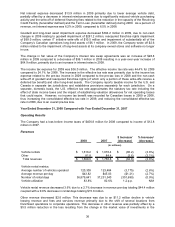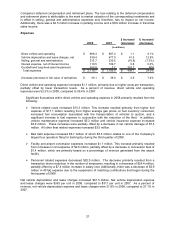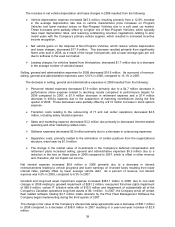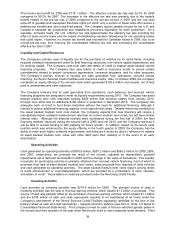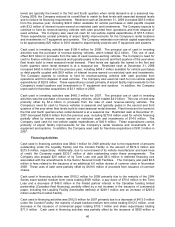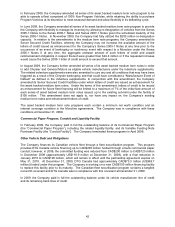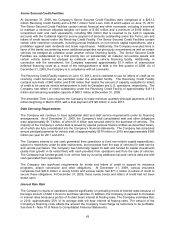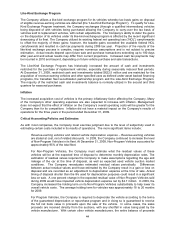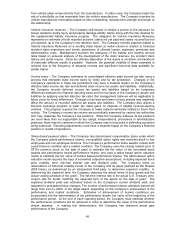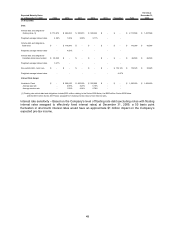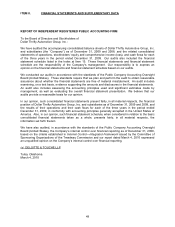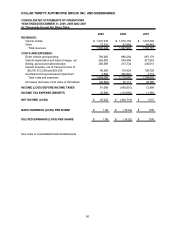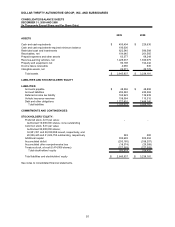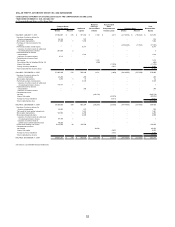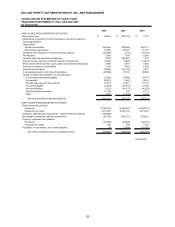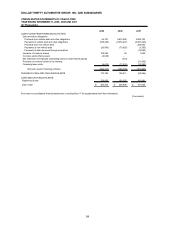Thrifty Car Rental 2009 Annual Report Download - page 45
Download and view the complete annual report
Please find page 45 of the 2009 Thrifty Car Rental annual report below. You can navigate through the pages in the report by either clicking on the pages listed below, or by using the keyword search tool below to find specific information within the annual report.Like-Kind Exchange Program
The Company utilizes a like-kind exchange program for its vehicles whereby tax basis gains on disposal
of eligible revenue-earning vehicles are deferred (the “Like-Kind Exchange Program”). To qualify for Like-
Kind Exchange Program treatment, the Company exchanges (through a qualified intermediary) vehicles
being disposed of with vehicles being purchased allowing the Company to carry-over the tax basis of
vehicles sold to replacement vehicles, with certain adjustments. The Company’s ability to defer the gains
on the disposition of its vehicles under its like-kind exchange program is affected by the recent significant
downsizing of its fleet. The Company utilized its existing federal net operating loss (“NOL”) carryforwards
to offset the majority of these gains; however, the taxable gains exceeded the available federal NOL
carryforwards and resulted in cash tax payments during 2009 tax year. Projection of the results of the
like-kind exchange process is complex, requires numerous assumptions and is not subject to precise
estimation. Actual results depend upon future sale and purchase transactions extending up to 180 days
after year-end and actual results may differ from current projections. Increased cash tax payments may
be incurred in 2010 and beyond, depending on future vehicle purchase and sale transactions.
The Like-Kind Exchange Program has historically increased the amount of cash and investments
restricted for the purchase of replacement vehicles, especially during seasonally reduced fleet periods.
At December 31, 2009, restricted cash and investments totaled $622.5 million and are restricted for the
acquisition of revenue-earning vehicles and other specified uses as defined under asset backed financing
programs, the Canadian fleet securitization partnership program and the Like-Kind Exchange Program.
The majority of the restricted cash and investments balance is normally utilized in the second and third
quarters for seasonal purchases.
Inflation
The increased acquisition cost of vehicles is the primary inflationary factor affecting the Company. Many
of the Company’s other operating expenses are also expected to increase with inflation. Management
does not expect that the effect of inflation on the Company’s overall operating costs will be greater for the
Company than for its competitors. Inflation did not have a material impact on the Company’s results of
operations for the three years in the period ended December 31, 2009.
Critical Accounting Policies and Estimates
As with most companies, the Company must exercise judgment due to the level of subjectivity used in
estimating certain costs included in its results of operations. The more significant items include:
Revenue-earning vehicles and related vehicle depreciation expense – Revenue-earning vehicles
are stated at cost, net of related discounts. In 2009, the Company continued to increase the level
of Non-Program Vehicles in its fleet. At December 31, 2009, Non-Program Vehicles accounted for
approximately 95% of the total fleet.
For Non-Program Vehicles, the Company must estimate what the residual values of these
vehicles will be at the expected time of disposal to determine monthly depreciation rates. The
estimation of residual values requires the Company to make assumptions regarding the age and
mileage of the car at the time of disposal, as well as expected used vehicle auction market
conditions. The Company reevaluates estimated residual values periodically. Differences
between actual residual values and those estimated by the Company result in a gain or loss on
disposal and are recorded as an adjustment to depreciation expense at the time of sale. Actual
timing of disposal shorter than the life used for depreciation purposes could result in a significant
loss on sale. A one percent change in the expected residual value of Non-Program Vehicles sold
during 2009 would have impacted vehicle depreciation expense net by $4.7 million. In 2009, the
Company increased the holding term on its Non-Program Vehicles substantially to help lower its
overall vehicle costs. The average holding term for vehicles was approximately 18 to 20 months
for 2009.
For Program Vehicles, the Company is required to depreciate the vehicle according to the terms
of the guaranteed depreciation or repurchase program and in doing so is guaranteed to receive
the full net book value in proceeds upon the sale of the vehicle. In some cases, the sales
proceeds are received directly from the auctions, with any shortfall in value being paid by the
vehicle manufacturer. With certain other vehicle manufacturers, the entire balance of proceeds
44


